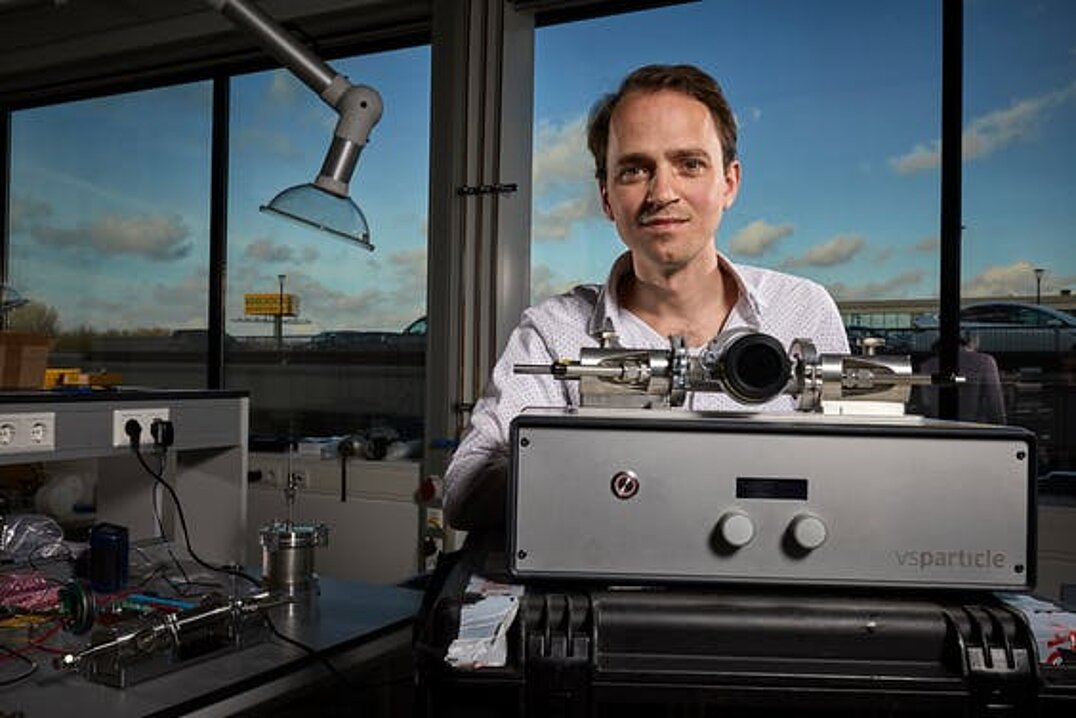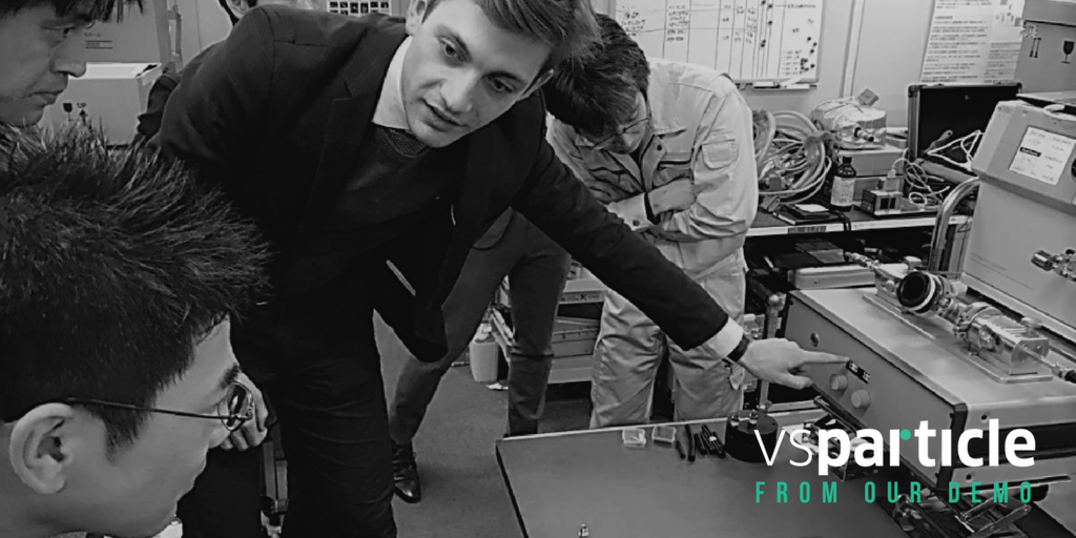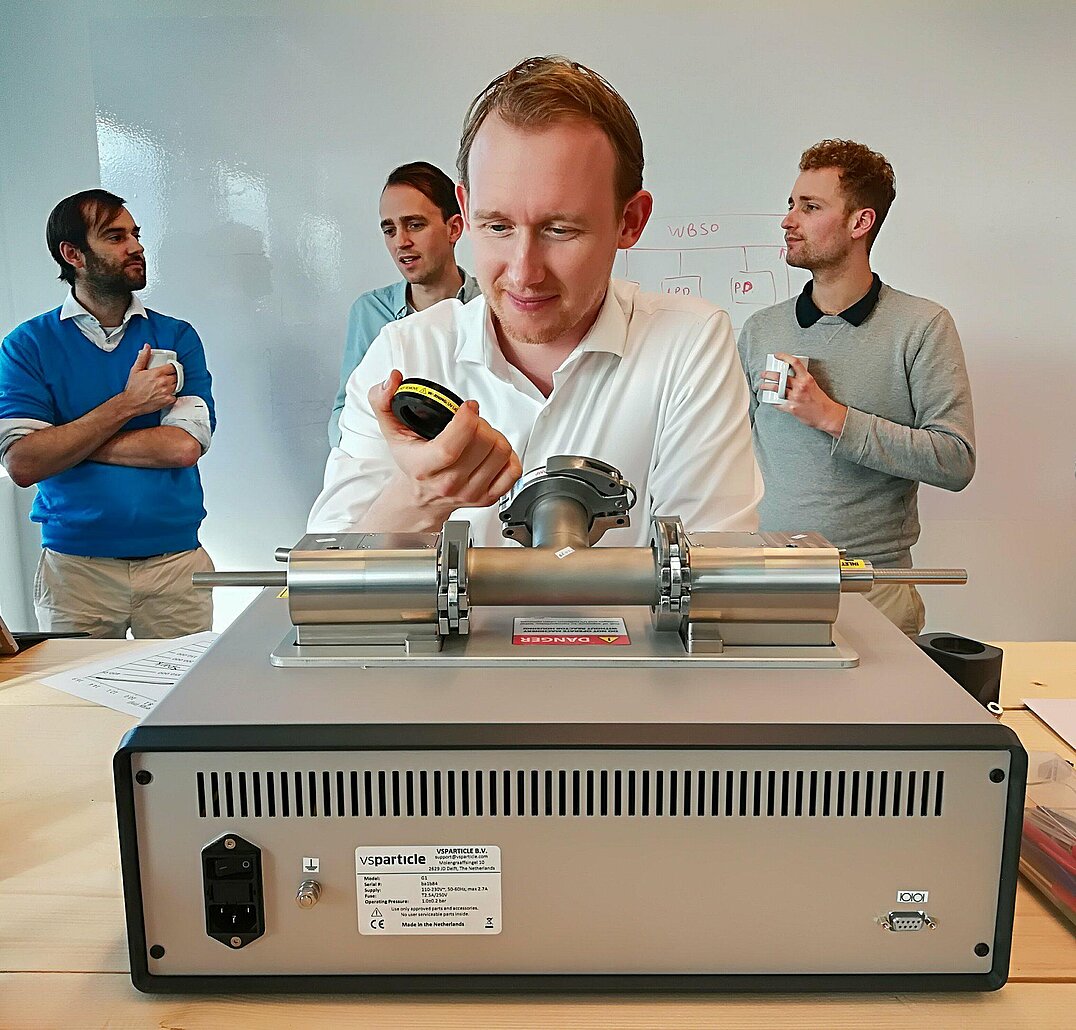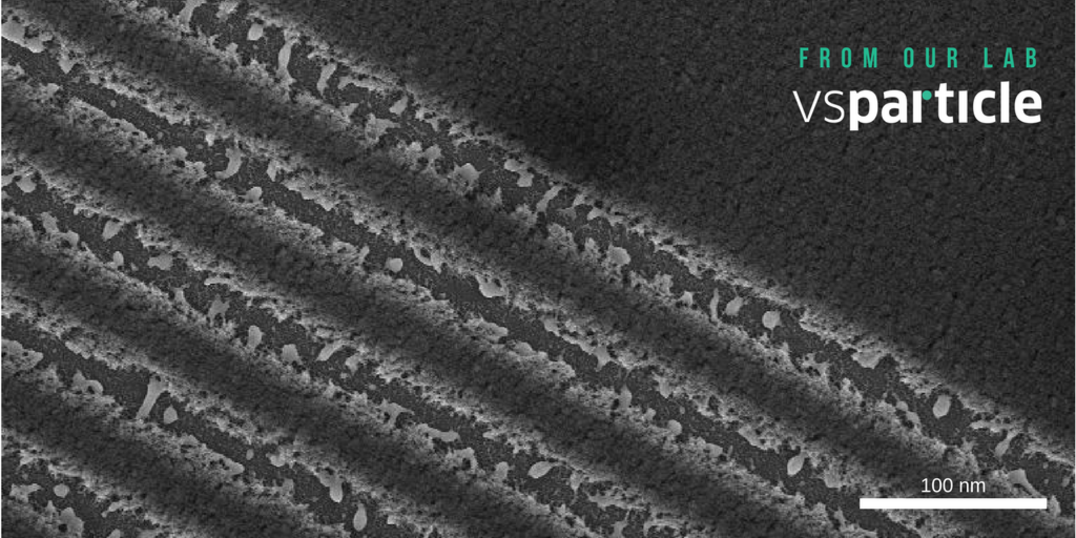Groter groeien met de kleinste deeltjes
English version: Grow bigger with the smallest particles
Delft, 5 april 2018 – VSPARTICLE uit Delft ontwikkelde een machine die in een paar minuten materialen tot op atomair niveau uit elkaar haalt en opnieuw opbouwt. Dit kan de ontwikkeling van nieuwe nanomaterialen in een stroomversnelling komen. Maar de vraag komt nu vooral uit de universitaire wereld, en die is onvoorspelbaar.
In de wereld waarin wij leven hebben materialen bepaalde fysische eigenschappen. Zo geleidt staal elektriciteit en smelt goud bij 1064 graden Celsius. Maar wie diezelfde grondstoffen heel klein maakt, komt in een andere werkelijkheid terecht. Dit is het domein van de nanodeeltjes, en daar voelt de Delftse start-up VSParticle zich thuis.
Teruggebracht tot nanoniveau krijgt een materiaal als goud opeens andere eigenschappen. De geleiding, de stijfheid, de kleur: al die fysische eigenschappen die typisch zijn voor dat materiaal veranderen.
En dat biedt mogelijkheden. Want door te spelen met de grootte en samenstelling van deze nanodeeltjes kunnen weer nieuwe materialen vervaardigd worden met nog onbekende eigenschappen. Volgens Aaike van Vugt, ceo van VSParticle, is dat vermogen om op nanoniveau nieuwe materialen te maken cruciaal voor innovaties die bijvoorbeeld een oplossing kunnen bieden voor klimaatverandering. ‘Nieuwe generaties batterijen of zonnepanelen kunnen nooit realiteit worden als we niet in staat zijn om betere materialen te ontwikkelen’
Maar het maken van nanodeeltjes is een complex, onbetrouwbaar en vooral tijdrovend proces. De meest gangbare methode gebruikt vloeistof en chemicaliën, waarbij elk deeltje een eigen receptuur heeft. En alleen al het maken van die receptuur kan maanden, soms jaren kosten.

Met de technologie van VSParticle kan dit worden teruggebracht tot enkele uren. De deeltjesbron werkt volgens een fysisch proces waarbij materialen door middel van een vonk zozeer verhit worden dat ze verdampen. Uit het wolkje materie distilleert het apparaat vervolgens de nanodeeltjes. Met één druk op de knop kan de machine elke grootte, combinatie en hoeveelheid deeltjes produceren met een extreem hoge mate van zekerheid en controleerbaarheid.
De technologie achter de deeltjesbron is bedacht door Andreas Schmidt-Ott, hoogleraar deeltjestechnologie aan de TU Delft. Samen met wetenschapper Tobias Pfeiffer bouwde hij vier jaar geleden een eerste versie van de machine. Van Vugt was toen nog student en gebruikte het apparaat voor zijn afstudeeronderzoek. ‘Ik kon daarmee in één dag nanodeeltjes maken, terwijl ik op conferenties hoorde hoeveel tijd en moeite dat andere onderzoekers kostte. Ik dacht dan vaak: kom even langs, dan maak ik die deeltjes wel voor je’. Hierdoor realiseerde Van Vugt zich de enorme waarde van het apparaat. ‘Ik vond dat elke onderzoeker hier gebruik van moest kunnen maken’.
Toen Schmidt-Ott hem vroeg of hij de technologie in de markt wilde zetten, hoefde Van Vugt niet lang na te denken. Samen met Schmidt-Ott en Pfeiffer begon hij in 2014 VSParticle. De ondernemers stonden wel voor een dilemma: zelf deeltjes maken en verkopen, of de machine optimaliseren, zodat anderen daarmee nieuwe materialen kunnen maken? Het werd het laatste. ‘We beseften dat de mogelijkheden oneindig zijn en kozen voor het meest schaalbare proces’, zegt Van Vugt. ‘Op die manier kunnen we veel meer impact maken’.
De eerste twee jaar besteedde het drietal aan het verbeteren en simplificeren van de deeltjesbron. ‘De prioriteit lag bij het vereenvoudigen van het proces, vertelt Van Vugt, ‘zodat onze klant alleen maar op een knop hoeft te drukken’. Ze krijgen subsidies en de TU Delft ruilt het intellectuele eigendom in voor een aandeel in het bedrijf. De eerste twee jaar verdienen de ondernemers nog niks, afgezien van wat prijzengeld van start-up-competities. Begin 2017 komt de eerste deeltjesbron van de band.

Het apparaat kost rond de € 60.000 en inmiddels levert de start-up machines in Nederland, Duitsland, de VS, China en Japan. De meeste klanten zijn universiteiten en onderzoeksinstituten, maar de vraag schommelt nog sterk. Een doorbraak in nano-onderzoek kan voldoende zijn om de vraag te verdubbelen. ‘We zijn op veel voorbereid, maar je weet nooit wanneer er ineens een run komt’, zegt Van Vugt.
De onderneming groeit snel. In anderhalf jaar tijd steeg het aantal medewerkers van 4 naar 20 man. ‘Maar we hebben nog nooit een vacature op de site gehad’, zegt Van Vugt. De meeste medewerkers zijn gepromoveerd en hebben een technische achtergrond. ‘Die hoef je niet zo veel uit te leggen. Want het blijft lastige stof’.
Begin dit jaar ontving de start-up enkele miljoenen groeikapitaal van Invaco Management, het investeringsvehikel van Keesjan Cordia, dat het jonge bedrijf begeleidt in het groeiproces. Ook leren de ondernemers veel van andere bedrijven. ‘Voor onze distributie in China hadden we een bedrijf op het oog dat onder andere voor Philips heeft gewerkt. Dus belden we Philips om te horen hoe die samenwerking liep. Omdat we jong en klein zijn, willen bedrijven dat soort info nog wel delen’.
VSPARTICLE richt zich vooralsnog op de onderzoekswereld omdat de rendementseisen voor het volume hier minder hoog liggen dan in de industrie. Wel werkt de start-up aan een deeltjesbron die voor industriële toepassing geschikt is. Volgend jaar komt het bedrijf bovendien met een 3D-printsysteem dat aan de bron kan worden gekoppeld. Die laatste toevoeging zou de productie van elektronica wel eens drastisch kunnen wijzigen. ‘Het huidige productieproces van bijvoorbeeld computerchips heeft zeven stappen en veel chemicaliën nodig om de koperpatroontjes te maken. Met onze bron kunnen wij pure koperdeeltjes maken, waarmee we de lijntjes vervolgens direct kunnen printen’.
Echte concurrentie heeft VSParticle nog niet, omdat het wereldwijd de enige is die deze deeltjesmachine bouwt. ‘Onze grootste uitdaging is de weerstand van wetenschappers, die decennia lang gewerkt hebben aan een proces om nanodeeltjes te maken met de vloeistofmethode’, zegt Van Vugt. ‘Zij zijn niet happig op een systeem dat in een klap hun ervaring van twintig jaar overbodig maakt’.
Het oordeel | 'Mooie technologie met grote marktkansen'
Wat vindt de neutrale investeerder van deze start-up? Deze week: Willem van den Berg.
'VSPARTICLE heeft in vier jaar tijd mooie technologie en bijbehorende toepassingen in nanomaterialen opgebouwd. Veel van de huidige nanodeeltjes worden geproduceerd op basis van chemische reacties, terwijl het proces van VSParticle is gebaseerd op fysica.
De keuze voor de researchmarkt is een logische start. Fors investeren in business development is nodig om meer oplossingen voor industriële klanten te genereren. De nanoprinter is een interessante oplossing: de gasvormige nanodeeltjes zijn via een printkopje op materiaal te printen. Aaike van Vught beschrijft het voorbeeld van koperen verbindingsstukjes voor chips en je zou denk ik ook op silicium of optische chips kunnen printen. Daarmee zou je ASM(L)-achtige processtappen kunnen overslaan, met forse marktimpact.
Het businessmodel: het maken van machines voor productie van nanomaterialen met een prijs van circa € 60.000 per machine. VSParticle zou moeten kijken hoe er meer maandelijks terugkerende omzet mogelijk is.
Het management bestaat uit een dynamisch team met technologische kennis en met forse commerciële drive. De financiering is met de huidige investeerder gezekerd voor de beoogde groei. Nu is het zaak om een sterke product en marktfocus aan te brengen: 'one nanometer wide en one mile deep'. VSParticle is een interessante investering met een sterke technologische 'edge', prachtige producten (nanoprinter) en grote marktkansen!'
Grow bigger with the smallest particles
Delft, april 5, 2018 -VSPARTICLE from Delft developed a machine that can break materials down to the atomic level and rebuild them in a matter of minutes. This can drastically increase the rate of development of new nanomaterials. However, the demand is currently coming from the academic world, and that world is unpredictable.
In the world we live in, materials have certain physical properties. [Steel], for instance, conducts electricity and gold has a melting point of 1064 degrees Celsius. But for who makes those same elements very small, a whole other reality is revealed. This reality is the world of the nanoparticles, and that is where start-up VSParticle from Delft, feels right at home.
Reduced to nanolevel, materials such as gold suddenly obtain different properties. Conductivity, stiffness, color: all those physical properties that are specific to those materials, change.
And that brings possibilities. Because by playing with the size and compositions of these nanoparticles, new materials can be created with still unknown properties. According to Aaike van Vugt, CEO of VSPARTICLE, this ability to create new materials at nanolevel is crucial for innovations that can, for instance, provide solutions for climate change. “New generations of batteries or solar panels can never become reality if we are not able to create better materials”.
Challenge no. 1 Anticipate the, at the moment unpredictable, demand from the field.
Challenge no. 2 Battle the resistance coming from established researchers
However, the production of nanoparticles is a complex, unreliable and, above all, time-consuming process. The most commonly used method uses fluids and chemicals, where every kind of particle has a different recipe. Just creating this recipe can take months, even years.
With the VSParticle technology, this can be reduced to several hours. The particle source applies a physical process where a spark is used to instantly heat up a material to such an extent that it evaporates. From this vapor cloud, the machine then extracts the nanoparticles. At the push of a button, the machine can generate every size and amount of particles with an extremely high certainty and controllability.
The technology behind this particle source was invented by Andreas Schmidt-Ott, Particles Technology Professor at TU Delft. Together with scientist Tobias Pfeiffer, they built a first version of the machine, four years ago. Back then, Van Vugt was still a student and he was using the machine for his master thesis. “I could make nanoparticles within a day with that machine, where, in the meantime, I heard on conferences how much time and effort it cost other researchers. I often thought: why don’t you drop by and I will make those particles for you”. This was how Van Vugt realized the immense value of the machine. “I believed that every scientist should be able to use this technology”.

When Schmidt-Ott asked him if he wanted to bring the technology to the market, Van Vugt didn’t have to think long. Together with Schmidt-Ott and Pfeiffer, he began VSPARTICLE in 2014. However, the entrepreneurs faced a dilemma: would they make and sell particles themselves? Or would they refine the machine and enable other people to make new materials with it? They concluded the latter. “We realized that the possibilities are endless and chose the best scalable process”, Van Vugt says. “This way we could make a bigger impact”.
The three spent the first two years on improving and simplifying the particle source. “We prioritized the simplification of the process, Van Vugt says, “in order for our customers, to only have to push a button”. They receive grants and the TU Delft trades the intellectual property for a share in the company. The first two years, the entrepreneurs make no profit, apart from some prizemoney from start-up competitions. At the beginning of 2017, the first particle generator is produced.
The machine costs about € 60.000 and now, the start-up delivers systems to The Netherlands, Germany, the US, China and Japan. Most of the customers are universities and research institutes, but the demand fluctuates. A break-through in nano research could be enough to double the demand. “We are prepared for a lot, but you never know when you suddenly grow faster”, says Van Vugt.
The company is growing fast. Over the course of eighteen months, the number of staff members grows from four to twenty. “But we never had a vacancy on the website”, says Van Vugt. Most of the staff members are Ph.D. graduates and have a technical background. “You don’t have to explain them as much, because it remains difficult material”.
At the beginning of this year, the company received several million in growth capital from Invaco Management, the investment company of Keesjan Cordia that supervises young companies in their growth. The entrepreneurs also learn a lot from other companies. “For our distribution in China, we were interested in a company that had worked for Philips among others. So we phoned Philips to ask how that collaboration had been. Because we are young and small, companies are still willing to share that sort of information”.
VSPA focusses on the research world for the time being, because the revenue requirements for the volume are less high there than in the industry. The company is working on a generator that is suitable for industrial application, however. More importantly, in the coming year, they will be introducing a 3D-printing system that can be mounted on the generator. That last addition could possibly impose a drastic change in the production of electronics. “The current production process of computer chips, for instance, requires seven steps and lots of chemicals to make the copper patterns. With our generator, we can make pure copper nanoparticles and print those lines directly on the chip”.
There is not yet real competition for VSParticle because, so far, they have been the only ones to build such particle generators. “Our biggest challenge is the resistance we encounter from scientists. Some of which have worked for decades on making nanoparticles in a liquid process”, says Van Vugt. “They are not very keen on seeing their experience of twenty years made redundant by this system”.

The verdict | ‘Beautiful technology with big market opportunities’
What does the neutral investor think of this start-up? This week: Willem van den Berg.
“In four years, VSPARTICLE has created beautiful technology and corresponding applications in nanomaterials. Most of the current nanoparticles are produced using chemical reactions, while the process of VSPARTICLE uses physics.
The choice to exploit the research market is a logical starting point. Investing heavily in business development is necessary to create more solutions for industrial clients. The nano printer is an interesting solution: the particles in gas phase can be printed on the material using a small print head. Aaike van Vugt describes the example of copper connectors on chips and I think you could also print on silicon or optical chips. Then you could skip ASM(L)-like processing steps, which would have a great impact on the market.
The business model: making machines for generating nanomaterials with a price tag of around € 60.000 per machine. VSPARTICLE should look at the possibilities of creating a higher monthly recurring revenue.
The management team consists of a dynamic group with technological knowledge and a big commercial drive. The financing for the predicted growth is sufficiently covered by the current investor. It is now time to add a strong product and market-focus: ‘one nanometer wide and one mile deep’. VSPARTICLE is an interesting investment with a strong technological edge, beautiful products (nano printer) and big market opportunities!”
Willem van den Berg is managing partner at Value Creation Capital, investor in high tech and IT with TechNano Fund and Security ofThings Fund.
Comments
No Comments